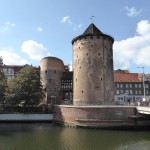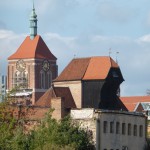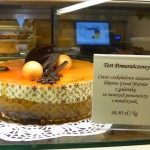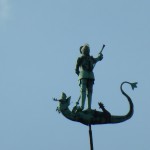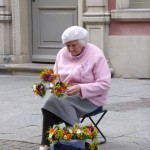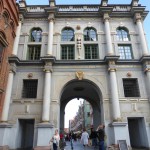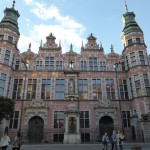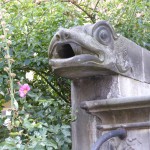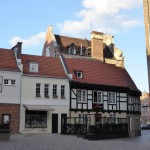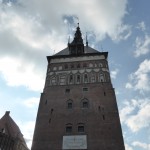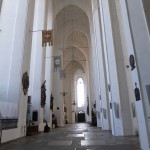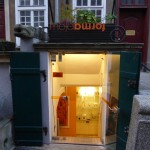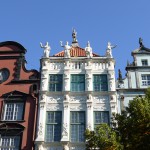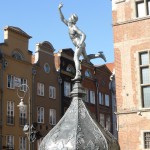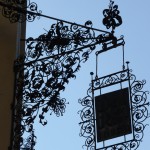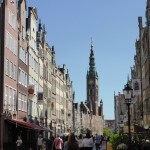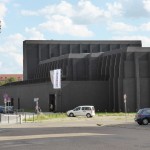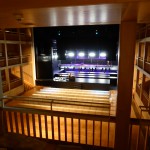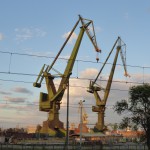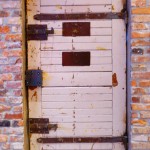Gdańsk
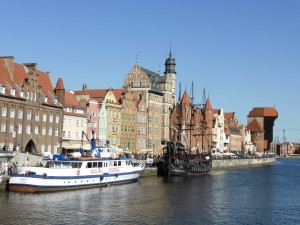 San t-Sultain am bliadhna bha mi ann an Gdańsk air costa tuath na Pòlainn – airson an darna turais, às dèidh seachd bliadhna. Bha sinn fortanach – bha sìde sgoinneil againn, deireadh-seachdain mu dheireadh an t-samhraidh, agus chunnaic sinn Gdańsk, agus am baile-mara faisg air, Sopot, anns a’ ghrian.
San t-Sultain am bliadhna bha mi ann an Gdańsk air costa tuath na Pòlainn – airson an darna turais, às dèidh seachd bliadhna. Bha sinn fortanach – bha sìde sgoinneil againn, deireadh-seachdain mu dheireadh an t-samhraidh, agus chunnaic sinn Gdańsk, agus am baile-mara faisg air, Sopot, anns a’ ghrian.
‘S e baile fìor bhòidheach ann th’ ann, làn beatha agus làn eachdraidh, le ceàrn acarsaid tarraingeach faisg air òs abhainn Vistula, agus fàileadh glan na mara. Tha na seann stràidean trang, beòthail, agus tha taighean-bìdh is cafaidhean gu leòr ann, gach uile fear le blas sònraichte aige fhèin. ‘S e ‘Red Door’ an taigh-bìdh a b’ fhearr leinne – bha sinn ann an turas mu dheireadh cuideachd. Agus aon rud math eile a tha aig Gdańsk – chan eil cus turasachd ann (fhathast).
Dh’èirich an Seann Bhaile mar ainneamhag on luaithre às dèidh lèirsgrios an Darna Chogaidh. Thòisich muinntir a’ bhaile sa bhad leis an ath-thogail, is iad airson cruth a’ bhaile aca a chumail dìreach mar a bha e roimhe, gun a bhith a’ cur thogalaichean ùra foincseanach ach grannda an àite nan taighean, eaglaisean agus geataichean-baile eachdraidheal brèagha. Mar sin chruinnich iad na seann bhricean, fiodh is iarann, eileamaidean sgeadachail, na dèilean, fiù ‘s na dorsan agus frèaman-uinneig nach robh ro mhillte, agus, leis a bhith a’ cleachdhadh seann dealbhan-ola, phlanaichean eachdraidheil agus dhealbhan-camara, ath-thog iad am baile. Agus sin ged nach robh fiù ‘s biadh
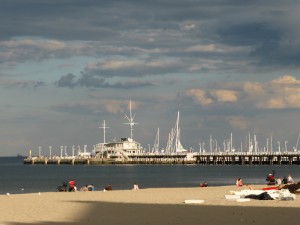 gu leòr aca aig an àm sin, agus cuid gun àite-fuirich ceart aca fhèin. Drùidhteach gu dearbh. San latha an-diugh, leis an t-seann bhreigearachd agus na sràidean caran cam mar a b’ àbhaist dhaibh a bhith, chan aithnicheadh tu gun do dh’fhuiling am baile cron-cogaidh sam bith. Tha na taighean, na ceàrnagan agus na cidhean ri taobh na h-abhainn ceart cho brèagha ‘s a bha iad aig àm a’ Cho-bhanna Hanseataigeach.
gu leòr aca aig an àm sin, agus cuid gun àite-fuirich ceart aca fhèin. Drùidhteach gu dearbh. San latha an-diugh, leis an t-seann bhreigearachd agus na sràidean caran cam mar a b’ àbhaist dhaibh a bhith, chan aithnicheadh tu gun do dh’fhuiling am baile cron-cogaidh sam bith. Tha na taighean, na ceàrnagan agus na cidhean ri taobh na h-abhainn ceart cho brèagha ‘s a bha iad aig àm a’ Cho-bhanna Hanseataigeach.
Chaidh sinn air an trèan gu Sopot, baile-mara tùrasachd leth-uair a thìde tuath air Gdańsk. Bha Sopot ainmeil mar àite shaor-làithean spaideil nan oifigearan àrda Comannach, le cilemeatairan de thràigh-ghainmhich agus cidhe fada eachdraidheal. San latha an diugh faodaidh muinntir nan trì bailtean Gdańsk, Sopot agus Gdynia ( an ‘Tricity’) an tràigh a chleachdadh agus brath a ghabal air na bùithtean agus taighean-osta spaideil agus na coilltean ‘s na slighean-baidhseagail air cùl na tràghad. Bha sinn fiù’s a plubraich ann an sàl blàth na Baltic.
Bidh Fèis Shakespeare air ann an Gdańsk gach samradh agus am bliadhna chaidh taigh-cluiche ùr a thogail aig oirthir an t-seann bhaile gus àite-fuirich maireannach a thoirt dhi. Tha e gu math connspaideach, mar bhogsa mòr dubh air an taobh a-muigh – coltas annasach am measg breigearachd ruadh bhlàth nan seann taighean – ach soilleir is ealanta na bhroinn. ‘S e taigh-cluiche ‘The Globe’ ann an Lunnain a bh’ anns a’ bheachd air cùl an togalaich seo. Bha companaidhean-cluiche aig 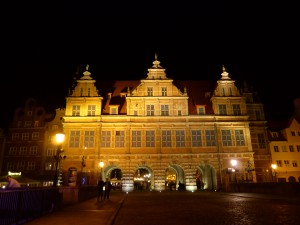 Gdańsk aig àm Shakespeare cuideachd, is iad a’ cleachdadh na seann sgoil-fheannsaireachd a bha suidhichte dìreach fon taigh-chluiche ùr.
Gdańsk aig àm Shakespeare cuideachd, is iad a’ cleachdadh na seann sgoil-fheannsaireachd a bha suidhichte dìreach fon taigh-chluiche ùr.
Ach an rud a rinn drùidheadh a bu mhotha orm, ‘s e an taigh-tasgaidh ùr mu ghluasad Solidarność, ann an Ionad Dlùth-phàirteachais Eòrpaich, a chaidh a thogail ann an gàrradh-iarainn Lenin, far an do thòisich crìonadh smachd nan Comannach. Taobh a-muigh chì thu siotaichean ana-mhòr meatailt meirgiche, a chuireas cuimhne air slige luinge, ach na bhroinn tha atrium an tigh-thasgaidh àrd is soilleir, le craoban agus lusan. Shuas an staidhre tha taisbeanadh Solidarność gar stiùreadh, air dòigh uabhasach cumhachdach, tro thachartasan nan làithean agus bliadhnaichean dràmadach sin. Tha e a’ foillseachadh dhuinn na buaidh mòir a bha aig na tachartasan sin air an Roinn Eòrpa air fad. Seo aon de na taighean-tasgaidh as fheàrr air a thadhail mi riamh (agus tha cuid mhath dhiubh anns a’ Phòlainn – tha iad fìor mhath orra…). ‘S e sgeul mu ghaisgeachd daoine àbhaisteach, mar Lech Wałęsa, ann an sùidheachadh neo-àbhaisteach a th’ ann – agus mu dheidhinn na dìleib a dh’fhàg iad againn.
Uile gu lèir ‘s e baile brèagha, beòthail is eachdraidheil a th’ ann an Gdańsk: mholainn dhuibh uile a dhol ann.
************************************************************************************
Gdańsk
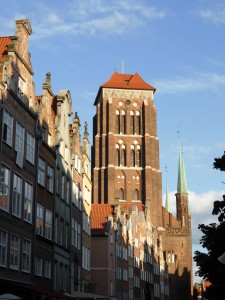 In September this year I was in Gdańsk, on the Polish Baltic coast – 7 years after my first visit. We were very lucky – we had brilliant weather, the last weekend of summer, and saw Gdańsk itself, and its beach resort Sopot, in sunshine.
In September this year I was in Gdańsk, on the Polish Baltic coast – 7 years after my first visit. We were very lucky – we had brilliant weather, the last weekend of summer, and saw Gdańsk itself, and its beach resort Sopot, in sunshine.
Gdańsk is a really lovely town, full of life as well as history, with a fascinating waterfront on the Vistula delta and fresh sea air. The old streets are busy and lively, and there are plenty of restaurants and cafés, each with its own special character. Our favourite restaurant was ‘Red Door’, which we had also been to on our first visit. And one other good thing about Gdańsk – there isn’t too much tourism (yet).
The Old Town rose like a phoenix from the ashes after the destruction in World War 2. The people of Gdańsk set about rebuilding their historic town as closely as they could make it to what it had been before, rather than building functional but ugly buildings in the place of the beautiful historic houses, churches and town-gates. They retrieved much of the original material from the rubble with their bare hands – bricks, wood and iron, floorboards, ornamental elements, even the doors and window frames that weren’t too badly damaged, and using paintings, old plans and photos as reference, rebuilt their town. And that was despite the fact that they didn’t even have enough food at that time, and some didn’t actually have a proper home themselves. Truly impressive. Nowadays,
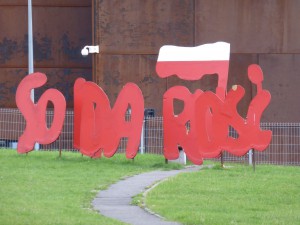 with the use of the old bricks and the original irregular street layout, you wouldn’t realise that the town had suffered any war damage at all. The mediaeval and Renaissance houses, the squares and the waterfront now look just as beautiful as they did at the time of the Hanseatic League.
with the use of the old bricks and the original irregular street layout, you wouldn’t realise that the town had suffered any war damage at all. The mediaeval and Renaissance houses, the squares and the waterfront now look just as beautiful as they did at the time of the Hanseatic League.
We took the train a few miles up the coast to Sopot, Gdańsk’s seaside resort. Sopot was famous as a smart holiday resort for the Communist party elite, with its long sandy beaches and an incredibly long historic pier. Nowadays the people of the three towns (the ‘Tricity’) of Gdynia, Sopot and Gdańsk can use the beach and enjoy the shops and smart hotels, and the woods and cycle-paths behind the beach. We took the chance to paddle in the (warm) Baltic.
Gdańsk has a Shakespeare festival every summer, and recently a new Shakespeare Theatre has been built to house it just outside the Old Town. It’s controversial, its almost black brick exterior contrasting with the surrounding warm red brick of traditional Gdańsk. But inside it’s light and elegant. It’s inspired by both the Globe in London, and its rectangular Gdańsk equivalent, the 17th c. Fencing School, whose remains lie below the theatre.
 But what I was particularly impressed and moved by was the Solidarność Museum in the new European Solidarity Centre, built in the old Lenin Shipyard where the fall of communism started. On the outside rusty metal plates, reminiscent of a ship’s hull, inside a high, light atrium, with trees and plants. Upstairs the atmospheric rooms of the Solidarność exhibition lead us powerfully through the dramatic events of the time, illuminating their subsequent great influence throughout Europe. This is one of the best museums I have ever been to (and some of the others are also in Poland – they are very good at them). The exhibition is the story of the heroism of ordinary people, like Lech Wałęsa, in extraordinary circumstances – and their legacy.
But what I was particularly impressed and moved by was the Solidarność Museum in the new European Solidarity Centre, built in the old Lenin Shipyard where the fall of communism started. On the outside rusty metal plates, reminiscent of a ship’s hull, inside a high, light atrium, with trees and plants. Upstairs the atmospheric rooms of the Solidarność exhibition lead us powerfully through the dramatic events of the time, illuminating their subsequent great influence throughout Europe. This is one of the best museums I have ever been to (and some of the others are also in Poland – they are very good at them). The exhibition is the story of the heroism of ordinary people, like Lech Wałęsa, in extraordinary circumstances – and their legacy.
All in all, Gdańsk is a beautiful, lively and historic town. I can really recommend a visit!
Barrachd fiosrachaidh / More information: http://www.inyourpocket.com/gdansk
